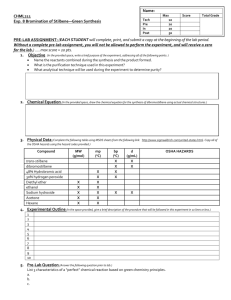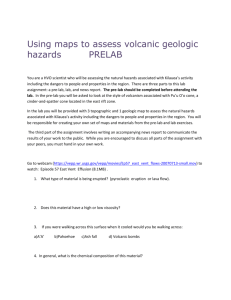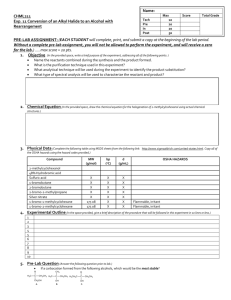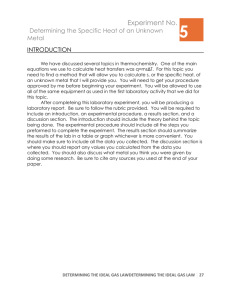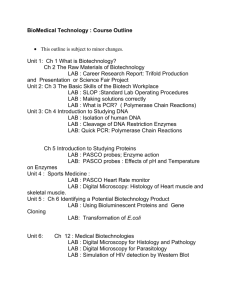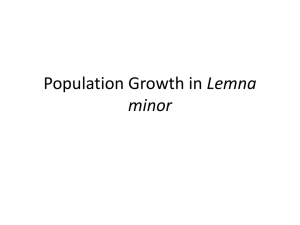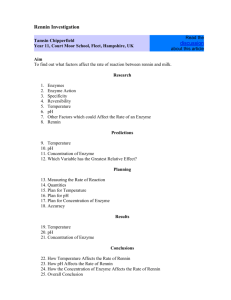Lesson Plan Summary Sheet
advertisement
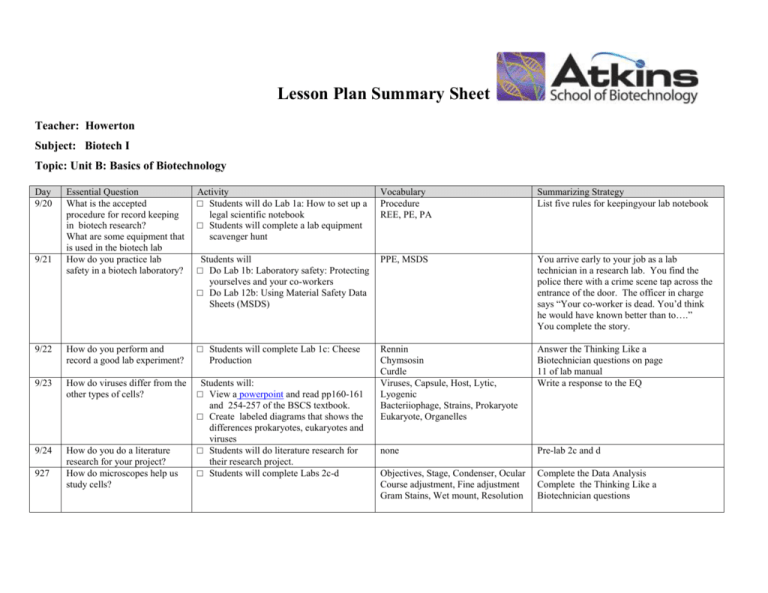
Lesson Plan Summary Sheet Teacher: Howerton Subject: Biotech I Topic: Unit B: Basics of Biotechnology Day 9/20 Essential Question What is the accepted procedure for record keeping in biotech research? What are some equipment that is used in the biotech lab How do you practice lab safety in a biotech laboratory? Activity □ Students will do Lab 1a: How to set up a legal scientific notebook □ Students will complete a lab equipment scavenger hunt Vocabulary Procedure REE, PE, PA Summarizing Strategy List five rules for keepingyour lab notebook Students will □ Do Lab 1b: Laboratory safety: Protecting yourselves and your co-workers □ Do Lab 12b: Using Material Safety Data Sheets (MSDS) PPE, MSDS You arrive early to your job as a lab technician in a research lab. You find the police there with a crime scene tap across the entrance of the door. The officer in charge says “Your co-worker is dead. You’d think he would have known better than to….” You complete the story. 9/22 How do you perform and record a good lab experiment? □ Students will complete Lab 1c: Cheese Production 9/23 How do viruses differ from the other types of cells? Answer the Thinking Like a Biotechnician questions on page 11 of lab manual Write a response to the EQ 9/24 How do you do a literature research for your project? How do microscopes help us study cells? Students will: □ View a powerpoint and read pp160-161 and 254-257 of the BSCS textbook. □ Create labeled diagrams that shows the differences prokaryotes, eukaryotes and viruses □ Students will do literature research for their research project. □ Students will complete Labs 2c-d Rennin Chymsosin Curdle Viruses, Capsule, Host, Lytic, Lyogenic Bacteriiophage, Strains, Prokaryote Eukaryote, Organelles none Pre-lab 2c and d Objectives, Stage, Condenser, Ocular Course adjustment, Fine adjustment Gram Stains, Wet mount, Resolution Complete the Data Analysis Complete the Thinking Like a Biotechnician questions 9/21 927 9/28 How do the various parts of a eukaryotic cell help it function? 9/29 How can we identify which biomolecules are present in a substance? 9/30 What are the properties of an enzyme? none 10/1 10/4 How are cells grow in the laboratory for study? 10/5 How does DNA carry our genetic code? How does the cell make the correct proteins? Students will □ View a powerpoint and read pp164165 in the BSCS textbook □ Create a labeled diagram of a eukaryote cell using functional analogies as parts Students will □ View a powerpoint □ Complete Lab 2a:Dissecting and Examining its Components in lab manual □ Students will complete the Catalase Lab □ Students may catch up, pre-lab future labs, or work on research project Students will: □ Complete the Pre-lab for Lab 2b □ Complete Lab 2b: The Characteristics of Model Organisms Students will: □ View films on gene expression □ Students will do some dry labs on the steps of gene expression 10/6 How do scientists manipulate the cell in biotechnology? Students will: □ Paper and scissor modeling of genetic engineering □ Film on genetic engineering 10/7 What have you learned about the basic scientific knowledge needed to do biotechnology? □ □ □ 10/8 What have you learned about the basic scientific knowledge needed to do biotechnology? □ Review a powerpoint on the unit Wrapup and Review Complete Notebook to turn in next day Test on this unit Nucleus, Nucleolus, Endoplasmic Reticulum, Ribosome, Golgi, Vacuoles Chloroplast, Mitochondria, Cell (plasma) membrane, Cell wall Make your own analogy for each of the cell parts. Prepare for a quiz on viruses, the cell and the microscope Pre-lab 2a Lipids, Proteins, Nucleic Acids, DNA RNA, Amino acids, Simple sugars Fatty acids, monomers, polymers Complete the Data Analysis and the Think Like a Biotechnician questions. Protein, enzyme, substrate, specificity, denature, structure none List five facts about an enzyme. Pre-lab 2b none Media, Agar, Culture, Incubate Aseptic, Laminar flow, Sterile Cell culture Complete the Data Analysis and the Thinking Like a Biotechnician Deoxyribose, Phosphate, Nitrogen bases, Double helix, Antiparallel, Replication,Nucleotides, mRNA, Transcription, Translation Amino acids, Codon, Anticodon tRNA, Polypeptide Recombinant, Plasmids, Vector Splicing,, Transgenic Genetic Engineering Explain why DNA is called the “blueprint of life” none none Rennin is used in the cheese industry to curdle milk. Rennin is made in the stomachs of calves but can vary from calf to calf. Explain how could you use recombinant DNA technology to improve the quality of cheese in the cheese industry. Write a Reflection about this unit and what and how you have learned none


